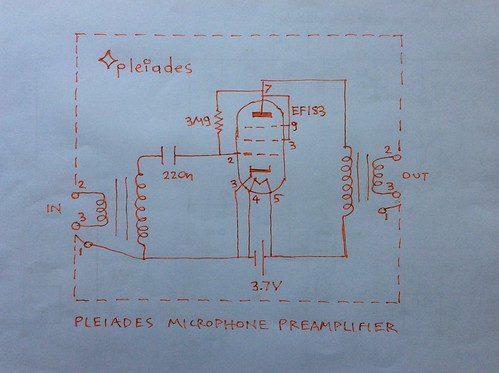A model must be created based on the following measurements. The voltage between grid and cathode of an electron tube is typically -700mV when heater voltage us applied and cathode reaches a typical temperature. When Pleiades bias is supplied by 6MΩ fron 4V anode to grid, the grid potential drops from a value of a few volts positive to -77mV. See previous posts and the Pleiades V6 schematic.

An intense battery in series with a resistor is a satisfactory model or equivalent circuit?
It may be considered positive terminal to cathode, resistor to grid? A typical value of internal resistor is 20KΩ at fairly normal cathode temperature before anode is connected to 1MΩ after anode is supplied with 4V, see Pleiades V6 schematic. (The 1 MΩ value is estimated by ohm's law considering that the potential on the grid increases from -700mV to -70mV at full operation of the Pleiadss V6 (both heater circuit and anode circuit connected) by deviding (700-70) by 0.6μA. 0.6μA is obtained by deviding 4V by 6MΩ. This may be wrong it has to be rechecked.)
More ideas are here needed.
The existence of this internal negative self bias can be accounted to the electron emission of the cathode. The cathode looses electrons hence becomes positive. As soon as we connect a heater voltage we can measure with any voltmeter a potential difference between grid and cathode of typically -700mV. (Attention if performing this experiment. A suitable fuse should always be connected in series with the heater voltage source for safety).
External means are needed to reduce this cutoff voltage so that operation of an electron tube can be possible with less than 4 volts at the anode or plate.
The Pleiades bias is a means of externally counteracting this negative bias so that an electron tube or electronic valve can operate at very low anode voltage. The bias is still negative but closer to 0V. A typical value is -70mV. This us achieved by a typical Pleiades bias resistor from anode to grid.
(For the automatic gain feature of electron tubes when the grid is start to be driven positive, diode side chain effect, a diode may be considered in an equivalent circuit. See also the Neumann U47 euroelectron posts on how the VF14 electron tube may exhibit variable gain when the bias is automatically varied by the diode effect.)
See also:
The Pleiades bias
Pleiades V6 schematic
Previous euroelectron posts
Operating Features of the Audion - E. H. Armstrong
Techniques for application of electron tubes in military equipment - page 1-10 -initial velocity grid current
http://www.dtic.mil/dtic/tr/fulltext/u2/142061.pdf
No comments:
Post a Comment